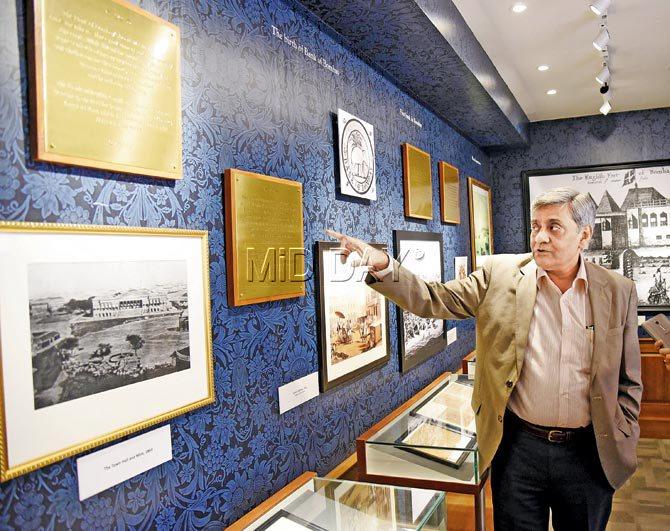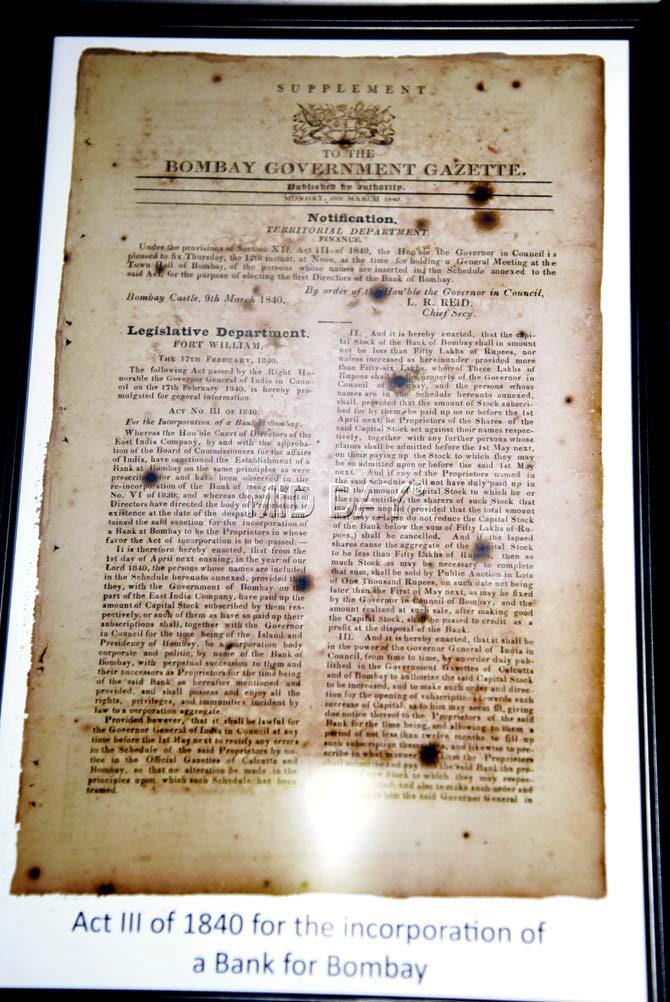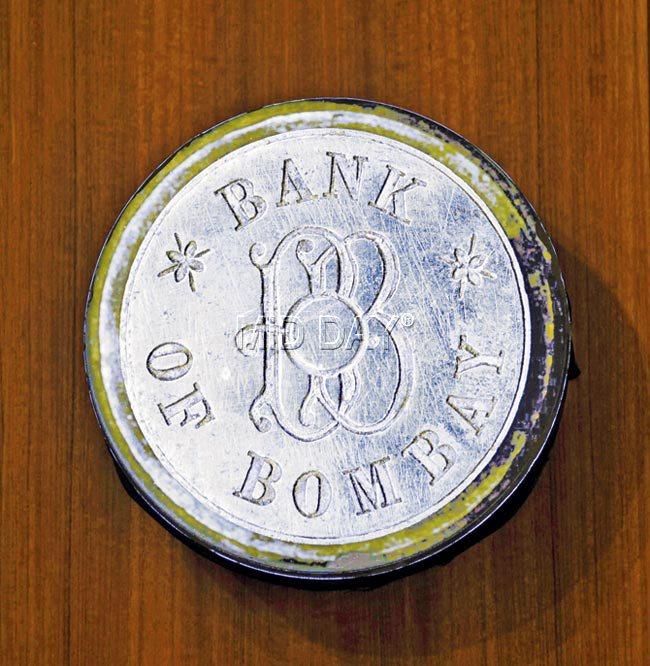The hitherto untold story of Bank of Bombay, one of the forebears of the State Bank of India, has been finally chronicled through rare documents and photographs at a newly opened heritage gallery at BKC


Chief general manager Deepankar Bose at the gallery. Pic/Pradeep Dhivar
It's not often that a commercial bank has looked beyond mundane money matters. But, a bank that has clocked no less than 200 years is no commonplace bank. The history of the State Bank of India is deeply embedded in the history of the country's freedom struggle, the reason why, in the year 1975, the bank commissioned renowned economist, professor Amiya Kumar Bagchi to document its story. That culminated into four volumes of books and eventually, the renowned State Bank archive in Kolkata, besides heritage galleries in Nagpur, Mumbai, Pune and Goa. However, the recently opened heritage gallery in Mumbai, at the BKC head office, is not like any of its predecessors.
ADVERTISEMENT

An account-opening statement of RD Tata at the New Bank of Bombay, 1899. Pic/Pradeep Dhivar
Called 'Down Memory Lane' this one is dedicated to the history of the Bank of Bombay, one of the most "interesting and adventurous" forebears of State Bank of India, according to Abhik Ray, the brains behind the gallery.

A page from Act III of 1840 for the incorporation of a Bank for Bombay. Pic/Pradeep Dhivar
Covering the period from 1840 to 1920, this space is home to some of the rarest displays excavated from the folds of history. We see pages from the bank prospectus, bank opening notices, advertisements, pages from old rule books, first legal tenders, notices of the bank being shut for Parsi New Year and the marriage of Prince of Wales (among other occasions), shareholders' list besides a collection of archival photos from that period. Among the special draws is an account opening statement of RD Tata, with the New Bank of Bombay, dated 1899. The gallery traces the history of the bank from inception to the time it shut during the American Civil War, its resurrection as the New Bank of Bombay and its amalgamation as an all-India bank when it got nationalised as SBI in 1955.

The emblem for the Bank of Bombay. Pic/Pradeep Dhivar
"As a semi-government bank that was set up in 1840, its main purpose was to stabilise the rates of interest and mobilise credit for the East India Company government in Bombay. A remarkable trait of this bank was how it operated in times of distress, raising loans during wars and famines. It stood its ground in a difficult business environment, and successfully financed manufacturing businesses, like the cotton mills for instance. Also, many of its customers were Indians, something that was not the case for its sister concerns — the Bank of Madras and Bank of Bengal. There were Indians on the board of directors, who were eminent industrialists. They would back Indian employees and borrowers," says Ray, who has authored two coffee-table books on the history of SBI and is in the process of penning the fifth volume of SBI's history. The former SBI deputy general manager (history), who has worked closely with Bagchi to document the bank's history, tells us that Bank of Bombay was the first bank to have a pension fund in place, and have retirement benefits for its Indian employees as well.
A reason why the story of this bank was harder to trace back, says Ray, is because all documents from the period between 1840 and 1867 were destroyed, when the bank had collapsed. "It was a deliberate ploy on the part of miscreants to hide their misdeeds. But, thankfully, some records and exchanges of communication with the government of Bombay, notices and so on, were available in the Maharashtra State Archives. What you see in the gallery is mostly retrieved from there," Ray tells us in a telephonic interview from Kolkata. What makes this bank even more intriguing is how its story ran parallel to India's nationalist movement. "Many individuals on the board were eminent nationalists," Ray says. "Dinshaw Edulji Wacha, one of the directors, joined the freedom movement and was one of the founders of the Indian National Congress, as was Pherozeshah Mehta, a customer of Bank of Bombay. When the Imperial Bank of India (which later transformed into SBI) was formed in 1921, Wacha was made director of the central board and he was the first to demand the Indianisation of the banking service."

A bench from the Bank of Bombay, sits right outside the heritage gallery at BKC. Pic/Pradeep Dhivar
There are two digitised stands in the gallery that allow visitors to read the history in detail, besides an audio-visual clip giving an overview of the story, in four parts. As he takes us through the gallery, chief general manager, Deepankar Bose tells us, "We don't know much about the history of the Bank of Bombay. The thought was to create a gallery which tells that story. Of all the presidency banks, this one is the most charismatic. This is the only bank that went out of business for seven years (1867-1874), and people don't know about it. And, this is again the bank which started the financing of industry. This story is very different from that of its counterparts."
While the gallery is open to public, by appointment only, most footfalls are from its staff. "The young staff members, especially, are not aware that the bank has such a rich history, interconnected with the freedom struggle and industrialisation. When they see something like this, they connect with the organisation better. That's why we create these heritage galleries. And history is always full of learning," Bose signs off.
 Subscribe today by clicking the link and stay updated with the latest news!" Click here!
Subscribe today by clicking the link and stay updated with the latest news!" Click here!







